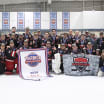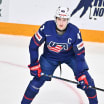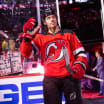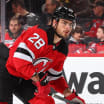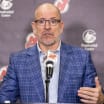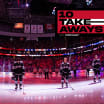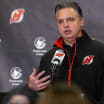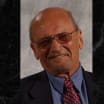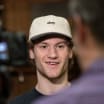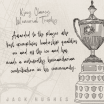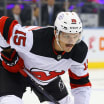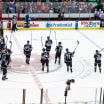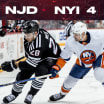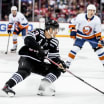Prior to the 1999-2000 NHL campaign, Devils general manager Lou Lamoriello had a message for the media; and it was stated in no uncertain terms.
"We're not in a rebuilding mode," The Boss asserted, "we're going for the Stanley Cup."
Seven months later, Lou had genius written all over him. The Devils were, in fact, making a Cup bid. En route, they challenged Philadelphia and became enveloped in one of the most thrilling seven-game series in NHL annals.
But looking back to the previous October (1999), Lou's promises didn't convince beat reporters. They figured Lamoriello was kidding about "not rebuilding" and, yes, going for The Cup.
For sure, there were reasons for doubt about the Devils fortunes; too many untried, new faces, the critics said. Plus, there was the matter of keen opponents.
SUNDAYS WITH STAN: 2000 Cup Special Edition - Lucky Seven
Stan Fischler writes about the history of the Devils franchise in his weekly column
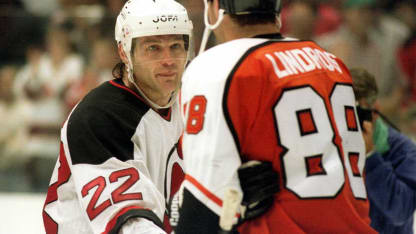
For one thing, the defending Stanley Cup champion Dallas Stars still were mighty. Who could beat them? Surely not the Devils. Or, so they said.
And for another -- despite Lou's protestations -- it certainly appeared as if his Garden Staters were, in fact, rebuilding. The following names underlined the point:
Exhibit A was Scott Gomez, a dipsy-doodling center fresh out of Junior hockey who seemed to be too small to handle the then roughhouse NHL. (Gomer went on to win the Calder Trophy as rookie-of-the-year.)
Exhibit B was Brian Rafalski, a defenseman built like a fireplug but who had been a virtual unknown playing in Europe. (The Wisconsin native became known, all right, as an ultra-reliable backliner with a radar shot.
Exhibit C was John Madden, a defensive forward who had graduated from New Jersey's AHL team, the Albany River Rats with minimal raves. (In no time at all John was revered as one of the NHL's best penalty-killers and clutch players.)
Exhibit D was Colin White, a defenseman who appeared too awkward and slow to be an effective regular. (White became a young Scott Stevens.).
There were other reasons not to place one's hopes on a second New Jersey championship, especially when it came to coaching.
While Robbie Ftorek ruled during most of the season, a bench-tossing episode in Detroit on January 30, 2000, cost him Lamoriello's confidence.
With just a handful of games remaining in the season -- on March 23, 2000 -- Ftorek was replaced by Hall of Fame defenseman Larry Robinson. And this, with the playoffs just around the calendar.
The abrupt -- totally unexpected -- coaching shake-up figured to negatively stun the hockey club to the very core. Instead, Larry would galvanize his outfit to new feats of triumph.
When the playoffs began, the Devils remained distinct underdogs; but then they disposed of an upstart Florida Panthers team and followed that with a stunning demolition job on the Toronto Maple Leafs.
Led by captain Scott Stevens -- cleverly partnered with the rookie Brian Rafalski -- the Devils defense became the talk of the league. One game against Toronto burnished this reputation.
On May 8, 2000, Robinson's outfit limited the Maple Leafs to a total of only six shotsover three periods of play and only a single shotin the third period. The Devils triumphed 3-0 and catapulted into the third round against the Flyers.
Philadelphia loomed as an equally talented opponent, paced by the skating dreadnought, Eric Lindros, then considered the league's most gifted boxcar on skates.
For starters, the Devils opened the series in Philly with a gratifying 4-1 victory. Sergei Brylin, who had suffered through a mediocre season, found his game with a pair of key assists.
His mates -- Scott Niedermayer, Petr Sykora Bobby Holik, and Claude Lemieux all found the net and the Devils were laughing.
"It was a good start," Brylin grinned, "but we knew that this would be a long one; they were loaded with talent."
The likes of Lindros, Rich Tocchet and Mark Recchi quickly turned the series around and before the Devils could say "We're in trouble," they were down.
three games to one. To some, they appeared about as alive as a Dodo Bird.
Following the third New Jersey loss, coach Robinson unleashed a scorched earth tirade at his players; totally at odds with Larry's laid-back personality. The scream session took the Devils by surprise but they were spurred by it.
"What Larry told us," said Marty Brodeur, "came from his heart. It touched a lot of players' feelings and put us on track again. There was no stopping us.'
For sure, Robbie's skaters weren't dead yet. They rebounded in Game Five with a 4-1 win in Philly followed by a 2-1 decision back home. Thus the stage was set for a Game Seven showdown in the City of Brotherly Love.
Except, there was no love lost on May 26, 2000; at least not in the hockey arena. Before a packed -- and very hostile building -- the Devils weathered an early Flyers assault and then went on a Bobby Holik-led power play.
"I had the puck in the Philly zone, left side and passed to Jason (Arnott), behind the net," Bobby recalled. "Then Jay saw Patrik (Elias) in front and put a pretty pass on his stick."
The Elias goal at 6:44 was followed by arguably the hardest bodycheck in Cup history. With the hulking Lindros -- head down -- zooming into the Jersey zone, Eric hit a concrete wall named Stevens and collapsed, unconscious.
Carried from the ice, Lindros no longer was a factor for Philly although Tocchet tied the score early in the middle frame. From then on until late in the third period, the teams were locked at 1-1 with no break in sight.
Then, it happened: with Elias at center stage and Alexander Mogilny, Stage Right.
"I moved to the front of the net when Alex took a shot from the right side," Patik remembered. "A Flyer defenseman thought he had me tied up but I got behind him for the loose puck and put it in; thanks to Alex."
A few more capital Brodeur saves were all that New Jersey needed to oust Philadelphia and move into the Stanley Cup Final against Dallas. And they got 'em.
"Now we have a chance to play for the Cup," shouted a jubilant Brodeur in the visitor's dressing room, post-game. "And maybe even win it."
No maybes about it!

